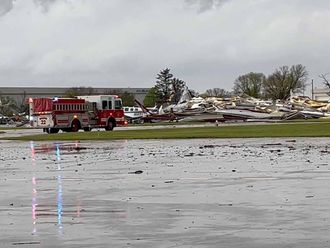HINESVILLE, Georgia: Every year, more than 25,000 Americans undergo surgery to correct a hiatal hernia, a condition in which tissue from the stomach bulges into the chest cavity through a hole in the diaphragm. The hernias often return, but major complications are rare. Hospitals stays are usually short.
Irene Smith, a 42-year-old cafeteria worker, wife of an Army sergeant and mother of three, was considered a good candidate for the procedure when she was evaluated in late 2007. A cardiologist’s report was especially positive.
“Lost about 25 pounds, exercising daily, looks fantastic,” he wrote.
But more than a dozen operations later, Smith has lost her stomach, her health, her job and almost all semblance of a normal life. She must purse most of her food. From her oesophagus to her intestines, she is such a jumble of abnormalities that two years ago one specialist declined to treat even her chronic cough for fear of making her worse.
“I do not mean to be rude or disrespectful,” she recalled him saying, “but I would not touch you with a 10-foot pole.”
Smith underwent hernia surgery at Winn Army Community Hospital in Fort Stewart, Georgia, one of 40 hospitals run by the armed forces. Her case illustrates what outside experts and dozens of current and former military hospital workers interviewed by The New York Times call a signal failing in a system that cares for 1.35 million active-duty service members and their families, among others.
Put simply, they say, many of the hospitals are so small and the trickle of patients so thin that it compromises the ability of doctors and nurses to capably diagnose and treat serious illnesses, much less take on surgeries like Smith’s.
Two-thirds of the hospitals last year served 30 or fewer inpatients a day — less than a third as many as the typical civilian hospital. Nine served 10 or fewer — so few that Dr Lucian L. Leape, a leading patient-safety expert at the Harvard School of Public Health, said, “I think they should be outlawed.”
These small and underused hospitals are the focus of an evolving Pentagon plan to scale back the system — entirely separate from the scandal-plagued veterans health system — by converting some of them into either outpatient clinics or birthing centres. The downsizing plan has not been made public, but Winn was among the hospitals listed in a draft distributed internally last spring and obtained by The Times.
The backdrop for the downsizing is a fiscal crisis. Four years ago, Defence Secretary Robert M. Gates said health care costs were “eating the Defence Department alive”; last year, they represented almost 10 per cent of the defence budget. Close to half of the beds in military hospitals appear to sit vacant, significantly more than the civilian hospital average.
Behind those fiscal woes, though, is a hospital system at odds with itself, struggling with conflicting missions that, according to many people interviewed, put not just the Pentagon’s coffers but the quality of care and patient safety at risk.
Pentagon health leaders say their hospitals’ paramount mission is military: to hone the skills that doctors and nurses will need in the carnage of combat. But their principal business is both broader and more mundane: They are essentially community hospitals, providing a smorgasbord of low-cost primary and speciality care, from births to breast implants to appendectomies.
Especially, but not only, at smaller hospitals, the military priorities undercut the day-to-day delivery of health care, doctors and nurses say.
Inexperienced doctors often assume outsize responsibilities because military policies encourage more experienced and ambitious clinicians to become administrators. Continuity, so crucial to medical care, is lost as hospital commanders and doctors, as well as patients, constantly rotate from post to post. The wars in Iraq and Afghanistan have taken an especially heavy toll: With many military doctors and nurses overseas, hospitals have been forced to shunt patients to civilian care, leaving empty beds and out-of-practice medical staffs.
To some veterans of the system, the inherent incongruities raise the question of whether, with limited exceptions, the military should even be in the hospital business.
“It’s a dangerous game,” said John Schafer, who served for eight years as deputy commander for clinical operations at Reynolds Army Community Hospital at Fort Sill in Oklahoma. “It is crazy that the military doesn’t say, hey, we are really good at outpatient medicine and this inpatient thing is out of our league.”
In February, Schafer left to become senior director of physician services at Comanche County Memorial Hospital, a 380-bed facility nearby. From his office, he can see the military hospital, which treats an average of just 13 patients a day.
“I loved that place,” he said. “But it should not be a hospital. I retired because I could see the unsafe care. Nobody was listening.”
Since late May, partly in response to months of inquiries from The Times, the Pentagon has been conducting a systemwide review of quality of care, patient safety and access to treatment. That report is expected soon, but hints of concern emerge from the draft downsizing plan. It warned that many military doctors, including general surgeons, were not busy enough to keep their skills sharp, and stated that medical literature demonstrated that bigger hospitals offered better care than smaller ones.












